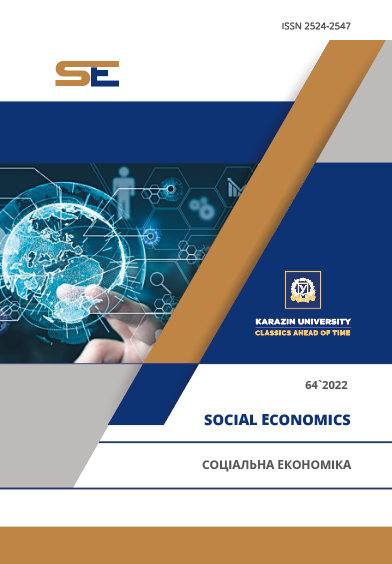ARCHITECTURE OF DECENTRALIZED APPLICATIONS AS PART OF THE DEFI ECOSYSTEM
Abstract
The functional features of cryptographic technologies in combination with decentralized data registries gave impetus to the development of the segment of decentralized financial assets. Evolutionarily, special decentralized applications were created that ensure the correct operation of the entire DeFi ecosystem. This work is devoted to the study of decentralized applications, since this is the main link of the market of decentralized finance, which provides an interface for the interaction of market subjects. In our work, we study the architecture of decentralized applications in particular detail. In the course of the work, we analyzed the dynamics of the creation of new decentralized applications on the main networks of the ecosystem. We found that most modern applications were created between 2017 and 2019, but new and newer use cases for decentralized applications are constantly emerging. We also identified and outlined the main categories of decentralized application architecture components. We added to the external parts of the architectural components: application developer, blockchain developer, application user, contract user, token user, consensus provider; and internal architectural components: client, smart contract, token, blockchain platform, other platforms. Several examples of the operation of blockchain protocols and the principles of transaction confirmation are in work. We created a detailed diagram of the interaction of all parts of the architecture, as well as subjects participating in the work of applications. We also explained the difference between tokens and coins, as well as accompanying conclusions regarding the practical side of the difference of decentralized assets. We also highlighted several features of the functioning of parts of the architecture of decentralized applications, in particular, management methods and the organization of interactions between different protocols in the middle of the DeFi ecosystem. We have also made appropriate conclusions on the work.
Downloads
References
Thomas, L. D. W., & Tee, R. (2022). Generativity: A systematic review and conceptual framework. International Journal of Management Reviews, 24, 255-278. doi: https://doi.org/10.1111/ijmr.12277
Yoo, Y. J., Henfridsson, O., & Lyytinen, K. (2010). The New Organizing Logic of Digital Innovation: An Agenda for Information Systems Research. Information Systems Research, 21(4), 724-735. doi: https://doi.org/10.1287/isre.1100.0322
Bakos, Y., Halaburda, H., & Mueller-Bloch, C. (2021). When permissioned blockchains deliver more decentralization than permissionless. Communications of the ACM, 64(2), 20-22. doi: https://doi.org/10.1145/3442371
Bamakan, S. M. H., Motavali, A., & Babaei Bondarti, A. (2020). A survey of blockchain consensus algorithms performance evaluation criteria. Expert Systems with Applications, 154, 113385. doi: https://doi.org/10.1016/j.eswa.2020.113385
Ferdous, M. S., Chowdhury, M. J. M., Hoque, M. A., & Colman, A. (2020). Blockchain Consensus Algorithms: A Survey. ArXiv:2001.07091v2 [cs.DC]. doi: https://doi.org/10.48550/arXiv.2001.07091
Tiwana, A., Konsynski, B., & Bush, A. A. (2010). Research Commentary ‒ Platform Evolution: Coevolution of Platform Architecture, Governance, and Environmental Dynamics. Information Systems Research, 21(4), 675-687. doi: https://doi.org/10.1287/isre.1100.0323
Casey, M. J., & Vigna, P. (2018). In blockchain we trust. MIT Technology Review, May/June 2018. Retrieved from https://www.technologyreview.com/2018/04/09/3066/in-blockchain-we-trust/.
Chen, Y., Pereira, I., & Patel, P. C. (2020). Decentralized Governance of Digital Platforms. Journal of Management, 0149206320916755. doi: https://doi.org/10.1177/0149206320916755
Schmeiss, J., Hoelzle, K., & Tech, R. P. G. (2019). Designing Governance Mechanisms in Platform Ecosystems: Addressing the Paradox of Openness through Blockchain Technology. California Management Review, 62(1), 121-143. doi: https://doi.org/10.1177/0008125619883618
Arazy, O., Lindberg, A., Rezaei, M., & Samorani, M. (2020). The evolutionary trajectories of peer-produced artifacts: Group composition, the trajectories’ exploration, and the quality of artifacts [Article]. Mis Quarterly, 44(4), 2013-2053. doi: https://doi.org/10.25300/misq/2020/15379
Bosu, A., Iqbal, A., Shahriyar, R., & Chakraborty, P. (2019). Understanding the motivations, challenges and needs of Blockchain software developers: a survey. Empirical Software Engineering, 24(4), 2636-2673. doi: https://doi.org/10.1007/s10664-019-09708-7
Walch, A. (2019). In Code(rs) We Trust: Software Developers as Fiduciaries in Public Blockchains. In P. Hacker, I. Lianos, G. Dimitropoulos, & S. Eich (Eds.), Regulating Blockchain: Techno-Social and Legal Challenges (pp. 58-81). Retrieved from https://www.academia.edu/37208269/IN_CODE_RS_WE_TRUST_ SOFTWARE_DEVELOPERS_AS_FIDUCIARIES _IN_PUBLIC_BLOCKCHAINS.
Sklavos, N., & Koufopavlou, O. G. (2005). Implementation of the SHA-2 Hash Family Standard Using FPGAs. The Journal of Supercomputing, 31, 227-248. doi: https://doi.org/10.1007/s11227-005-0086-5
Kalodner, H., Carlsten, M., Ellenbogen, P., Bonneau, J., & Narayanan, A. (2015). An empirical study of namecoin and lessons for decentralized namespace design. 14th Annual Workshop on the Economics of Information Security, {WEIS}, 2015, Delft, The Netherlands, 22-23 June, 2015. Retrieved from http://www.econinfosec.org/archive/weis2015/papers/WEIS_2015_kalodner.pdf.
Zamani, M., Movahedi, M., & Raykova, M. (2018). Rapidchain: Scaling blockchain via full sharding, in: Proceedings of the 2018 ACM SIGSAC Conference on Computer and Communications Security (pp. 931-948). doi: https://doi.org/10.1145/3243734.3243853
Xu, X., Pautasso, C., Zhu, L., Gramoli, V., Ponomarev, A., Tran, A. B., & Chen, S. (2016). The blockchain as a software connector. 13th Working IEEE/IFIP Conference on Software Architecture (WICSA), IEEE (2016) (pp. 182-191). Retrieved from https://design.inf.usi.ch/sites/default/files/biblio/2016_WICSA_ BlockChainSoftwareConnector.pdf.
Shafagh, H., Burkhalte,r L., Hithnawi, A., & Duquennoy, S. (2017). Towards blockchain-based auditable storage and sharing of iot data. Proceedings of the 2017 on Cloud Computing Security Workshop, ACM (2017) (pp. 45-50). doi: https://doi.org/10.1145/3140649.3140656
Johnston, D., Yilmaz, S. O., Kandah, J., Bentenitis, N., Hashemi, F., Gross, R., Wilkinson, S., & Mason, S. (2014). The general theory of decentralized applications – Dapps. Retrieved from http://cryptochainuni.com/wp-content/uploads/The-General-Theory-of-Decentralized-Applications-DApps.pdf.
Azzia, R., Chamouna, R., & Sokhn, M. (2019). The power of a blockchain-based supply chain. Comput. Ind. Eng., 135, 582-592. doi: https://doi.org/10.1016/j.cie.2019.06.042
Lawrenz, S., Sharma, P., & Rausch, A. (2019). Blockchain technology as an approach for data marketplaces. Proceedings of the 2019 International Conference on Blockchain Technology; 15–18 Mar 2019; Honolulu, HI, USA, ACM, New York, NY, USA (2019) (pp. 55-59). doi: https://doi.org/10.1145/3320154.3320165




